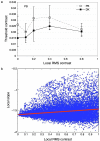Contrast sensitivity in natural scenes depends on edge as well as spatial frequency structure
- PMID: 19810782
- PMCID: PMC3612947
- DOI: 10.1167/9.10.1
Contrast sensitivity in natural scenes depends on edge as well as spatial frequency structure
Abstract
The contrast sensitivity function is routinely measured in the laboratory with sine-wave gratings presented on homogenous gray backgrounds; natural images are instead composed of a broad range of spatial and temporal structures. In order to extend channel-based models of visual processing to more natural conditions, we examined how contrast sensitivity varies with the context in which it is measured. We report that contrast sensitivity is quite different under laboratory than natural viewing conditions: adaptation or masking with natural scenes attenuates contrast sensitivity at low spatial and temporal frequencies. Expressed another way, viewing stimuli presented on homogenous screens overcomes chronic adaptation to the natural environment and causes a sharp, unnatural increase in sensitivity to low spatial and temporal frequencies. Consequently, the standard contrast sensitivity function is a poor indicator of sensitivity to structure in natural scenes. The magnitude of masking by natural scenes is relatively independent of local contrast but depends strongly on the density of edges even though neither greatly affects the local amplitude spectrum. These results suggest that sensitivity to spatial structure in natural scenes depends on the distribution of local edges as well as the local amplitude spectrum.
Figures










References
-
- Atick JJ. Could information theory provide an ecological theory of sensory processing? Network: Computation in Neural Systems. 1992;3:213–251. - PubMed
-
- Balboa RM, Grzywacz NM. Occlusions and their relationship with the distribution of contrasts in natural images. Vision Research. 2000;40:2661–2669. PubMed. - PubMed
-
- Balboa RM, Grzywacz NM. Power spectra and distribution of contrasts of natural images from different habitats. Vision Research. 2003;43:2527–2537. PubMed. - PubMed
-
- Barlow HB. Possible principles underlying the transformation of sensory messages. In: Rosenblith WA, editor. Sensory communication. MIT Press; Cambridge, MA: 1961. pp. 217–234.
-
- Betsch BY, Einhäuser W, Körding KP, König P. The world from a cat’s perspective—Statistics of natural videos. Biological Cybernetics. 2004;90:41–50. PubMed. - PubMed
Publication types
MeSH terms
Grants and funding
LinkOut - more resources
Full Text Sources

